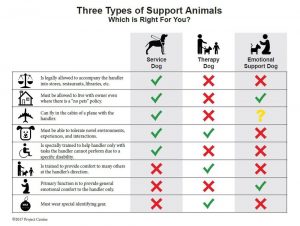 Many of us incorrectly use these terms interchangeably, but really should not as there’s a definite difference between these three working dog classifications: Service, Support & Therapy Dogs!
Many of us incorrectly use these terms interchangeably, but really should not as there’s a definite difference between these three working dog classifications: Service, Support & Therapy Dogs!
Service dogs
Service dogs help people who are physically disabled, sight and/or hearing-impaired, wheelchair bound, or have other health challenges that limit their quality of life and independence. Service dogs can perform normal everyday tasks that these individuals cannot do for themselves. Service dogs are trained to respond to particular disabilities, and some can alert to an imminent health issue (seizure, drop in glucose) prompting their human to take action and prevent a crisis.
Emotional support dogs
Unlike other working dogs, emotional support dogs don’t necessarily perform specific tasks. Rather…they provide affection, companionship and support to people with diagnosed disabilities – mental or emotional — such as PTSD, depression, autism, anxiety and various phobias. They keep people calm, happy and fear-free…jobs that a pet does too but in a more specialized and trained for capacity.
Therapy dogs
Unlike support and service or guide dogs, therapy dogs are trained to help other people besides their owners or handlers. These dogs are often taken into hospitals and nursing homes to provide stimulation and therapeutic support to patients and residents. Other therapy dogs go into schools for educational purposes or to serve as “reading buddies” for children who are having difficulties with literacy.
 Southeastern Guide Dogs in Palmetto, Florida trains all three types of working dogs. Depending on your needs, you must participate in a 3- to 20-day training course in which you will learn how to practice basic obedience and/or commands with your selected dog, as well as how to maintain his training. Applications are available online at www.guidedogs.org
Southeastern Guide Dogs in Palmetto, Florida trains all three types of working dogs. Depending on your needs, you must participate in a 3- to 20-day training course in which you will learn how to practice basic obedience and/or commands with your selected dog, as well as how to maintain his training. Applications are available online at www.guidedogs.org
 Comprehensive Pet Therapy Inc. trains dogs for the hearing impaired and for assistance with seizures as well as for therapy and other tasks. Beginning with basic obedience commands, transitioning to more service-oriented training, and then public access training for service work. In between these training sessions, the dogs go home to bond with their families and to mature. Learn more about their GRReat work at https://cpt-training.com
Comprehensive Pet Therapy Inc. trains dogs for the hearing impaired and for assistance with seizures as well as for therapy and other tasks. Beginning with basic obedience commands, transitioning to more service-oriented training, and then public access training for service work. In between these training sessions, the dogs go home to bond with their families and to mature. Learn more about their GRReat work at https://cpt-training.com
There are other organizations as well, so find one near you if you or a loved one could benefit from a working dog. Service, support and therapy dogs can make a tremendous difference to people in need. They can literally be a person’s eyes, hands and ears. Dogs in all these categories must have a good temperament. They need to be calm, focused and comfortable around humans and other animals. They learn that they are working when they wear their specialized vest, harness or collar and to ignore distractions as well as control behavioral impulses. A service dog can’t perform if a squirrel or the smell of a burger takes him off focus!
If you see a dog wearing his vest, collar or harness, please do not touch or disturb him from his most important work, and…if you have a dog who is truly not trained to be a service, support or therapy dog, please do not try to pass him off as one. He is still your wondeRUFFul loving companion, but do not jeopardize the privileges dogs who have worked so hard to attain have been given. It hurts them and the humans they love to help!
Watch for my blog on this topic: https://youtu.be/B-pBr9ConU4








